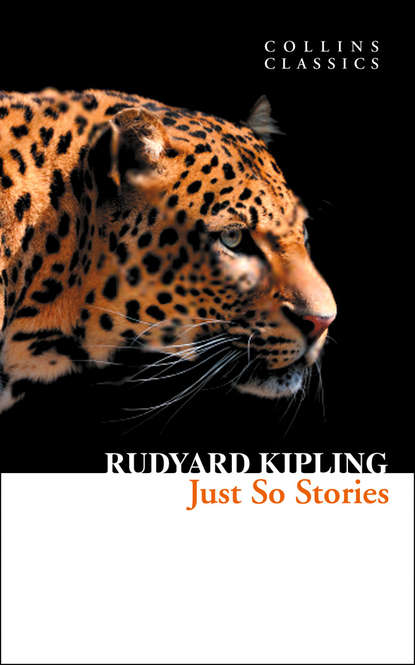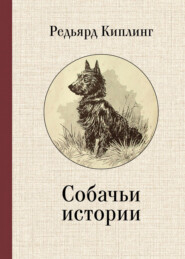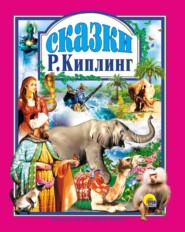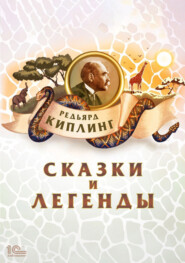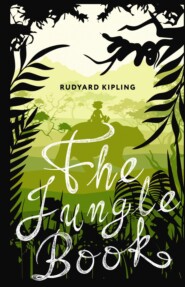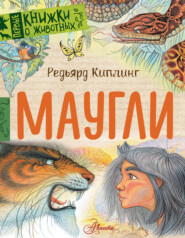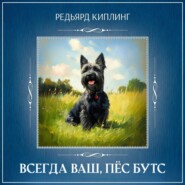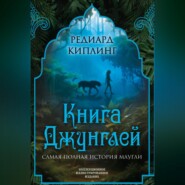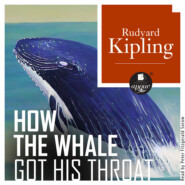По всем вопросам обращайтесь на: info@litportal.ru
(©) 2003-2025.
✖
Just So Stories
Настройки чтения
Размер шрифта
Высота строк
Поля
Just So Stories
Rudyard Kipling
How did the leopard get its spots? Why do the tides ebb and flow? How did the elephant get its trunk? And how was the alphabet made?Rudyard Kipling’s classic collection of fables answers the great questions of animal- and humankind, in a fun, eloquent, and magical way – for children and adults alike. Kipling’s beautifully imaginative answers echo the animal fables he heard during his childhood in India, paired with the folk tales he collected throughout his life.Kipling’s enjoyment in playing with language, as well as his own delight in fatherhood, makes these stories a joy to read aloud, and children will request these tales as bedtime stories again and again. However, adults will also revel in Kipling’s fanciful storytelling and gift for language, as every reading uncovers a new joke, subtext, or fascinating embellishment. From the author of The Jungle Book and Kim, Just So Stories is the newest addition to the available canon of Kipling’s work available in the handy format of Collins Classics!
JUST SO STORIES
Rudyard Kipling
CONTENTS
Title Page (#u5a5b2dbd-8f31-5dfd-8c14-14e587db6abb)
History of Collins (#uce467832-75dc-5936-999b-9da5872c4c28)
Life & Times (#u3138f5f3-3186-52a9-901f-0f9c846510e7)
How the Whale Got His Throat (#u5fc258d5-dd7f-5b8d-8ddd-e089bdae0f50)
How the Camel Got His Hump (#u90286bf9-038a-5df8-9a29-26d86322db98)
How the Rhinoceros Got His Skin (#u2e0ed6ae-ed13-5d53-bb97-0c9080319284)
How the Leopard Got His Spots (#u8ec1b063-d7d5-5d3e-94c9-8ae3e86a070f)
The Elephant’s Child (#ub95a22be-f9f5-59c9-9a0e-8abdcea27bb6)
The Sing-Song of Old Man Kangaroo (#u665b12c2-5331-5532-b02a-9c81ac0d05c9)
The Beginning of the Armadilloes (#litres_trial_promo)
How the First Letter was Written (#litres_trial_promo)
How the Alphabet was Made (#litres_trial_promo)
The Crab that Played with the Sea (#litres_trial_promo)
The Cat that Walked by Himself (#litres_trial_promo)
The Butterfly that Stamped (#litres_trial_promo)
Footnotes (#litres_trial_promo)
Classic Literature: Words and Phrases adapted from the Collins English Dictionary (#litres_trial_promo)
Copyright (#litres_trial_promo)
About the Publisher (#litres_trial_promo)
History of Collins
In 1819, millworker William Collins from Glasgow, Scotland, set up a company for printing and publishing pamphlets, sermons, hymn books and prayer books. That company was Collins and was to mark the birth of HarperCollins Publishers as we know it today. The long tradition of Collins dictionary publishing can be traced back to the first dictionary William published in 1824, Greek and English Lexicon. Indeed, from 1840 onwards, he began to produce illustrated dictionaries and even obtained a licence to print and publish the Bible.
Soon after, William published the first Collins novel, Ready Reckoner, however it was the time of the Long Depression, where harvests were poor, prices were high, potato crops had failed and violence was erupting in Europe. As a result, many factories across the country were forced to close down and William chose to retire in 1846, partly due to the hardships he was facing.
Aged 30, William’s son, William II took over the business. A keen humanitarian with a warm heart and a generous spirit, William II was truly ‘Victorian’ in his outlook. He introduced new, up-to-date steam presses and published affordable editions of Shakespeare’s works and Pilgrim’s Progress, making them available to the masses for the first time. A new demand for educational books meant that success came with the publication of travel books, scientific books, encyclopaedias and dictionaries. This demand to be educated led to the later publication of atlases and Collins also held the monopoly on scripture writing at the time.
In the 1860s Collins began to expand and diversify and the idea of ‘books for the millions’ was developed. Affordable editions of classical literature were published and in 1903 Collins introduced 10 titles in their Collins Handy Illustrated Pocket Novels. These proved so popular that a few years later this had increased to an output of 50 volumes, selling nearly half a million in their year of publication. In the same year, The Everyman’s Library was also instituted, with the idea of publishing an affordable library of the most important classical works, biographies, religious and philosophical treatments, plays, poems, travel and adventure. This series eclipsed all competition at the time and the introduction of paperback books in the 1950s helped to open that market and marked a high point in the industry.
HarperCollins is and has always been a champion of the classics and the current Collins Classics series follows in this tradition – publishing classical literature that is affordable and available to all. Beautifully packaged, highly collectible and intended to be reread and enjoyed at every opportunity.
Life & Times
About the Author
Rudyard Kipling was born in Mumbai, formerly known as Bombai, when it was part of British India during the days of the British Empire. He was born in 1865, the year that Lewis Carroll’s Alice’s Adventures in Wonderland was published, undoubtedly a genre of writing that later influenced his work. At the age of six, Kipling was sent to England to continue his education. He was deeply unhappy during this part of his childhood and it seems that this was when he began inventing companions in the form of anthropomorphic animals.
Having finished his schooling, Kipling returned to British India to become assistant editor of a newspaper in Lahore, which is now in Pakistan. He immediately felt at home and quickly forgot about his time in England. In 1887 Kipling moved from Lahore to Allahabad to work on another newspaper. He had already published a great many short stories by this time and two years later left India on a world tour. This included a trip across the United States and then a voyage by boat to England. Having ensconced himself in London he published his first novel The Light that Failed (1890), but evidently had a crisis of self-confidence and suffered a nervous breakdown. His personal life was set to change in 1892 however, when he married Carrie Balestier, the sister of Wolcot Ballestier, with whom he had collaborated on another book.
Their honeymoon took them to Vermont in the United States, where they decided to settle because Carrie had fallen pregnant. The Kiplings remained in Vermont for four years. During this period Rudyard appeared to be content and wrote his best known work, The Jungle Book. Unfortunately a political crisis between Britain and the United States led to anti-British sentiment and Kipling felt it most from the press. A family feud between the Kiplings and Carrie’s brother proved the final straw and sealed Rudyard’s decision to leave America.
The Kipling family moved to the south coast of Devon, England and then East Sussex from 1902. By now Kipling was a famous man and enjoyed his growing celebrity in the first decade of the 20th century. In 1907 he won the Nobel Prize for Literature, such was his fame and reputation worldwide. World War I was, however, to have a tragic outcome for the Kiplings. In 1915 their son John was killed. He had gone to war in the blind spirit of enthusiasm that characterized the age and fallen at the Battle of Loos. Kipling felt eternal guilt at his son’s death because he had used his influence to get John accepted into the army following his initial rejection for having poor eyesight.
Following Kipling’s own death in 1936 his work became rather unfashionable, partly because of changing tastes and partly because the British Empire began to disintegrate following World War II. British India itself gained its independence from colonial rule in 1947 and was partitioned into Pakistan and India. In the latter half of the 20th century Kipling’s work became part of the cannon of English literary history, especially his two Jungle Book collections, and he is now considered one of the all time greats.
In India, his legacy is a matter of contention because his writing is centred on colonial times and many of his characters are intrinsically racist. It isn’t that Kipling himself was prejudiced particularly, but that the culture among the British colonists was superior in its view of the natives. Kipling therefore wrote his characters as he witnessed real people around him. It would be true to say that many Europeans had an elitist attitude to non-Caucasian races at that time, so it would be inappropriate to judge Kipling by modern standards of political correctness.
The Jungle Book
When The Jungle Book is mentioned, most people think of the Disney animated film. This actually has very little to do with the stories of Rudyard Kipling, as Walt Disney only took the basic idea of anthropomorphic jungle animals and transformed them into lovable children’s characters. Kipling’s characters and stories are far darker and fantastical. In fact, Kipling deliberately wrote his stories as fables, to provide moral and ethical guidance to his readers, both young and old. The first collection of stories was published in 1894, quickly followed by a second in 1895, appropriately titled The Second Jungle Book.
Mowgli, the central human character, is a young boy who has been raised by a she wolf. He is thus in the unique position of being able to communicate with the various animals of the jungle. There had been various tales of children having been raised by wild animals and this is where Kipling drew his inspiration from. Some of those tales had an element of truth to them, but the majority were myths. Nevertheless, they made a solid foundation for Kipling’s stories, as Mowgli was the ideal transitional character. In essence he was half human, half animal in his psychology. He also possessed the naivety of a child and was therefore open-minded and fearless.
Mowgli appears in three of the stories in The Jungle Book. There are seven all told, with a song chapter following each one. As well as Mowgli and his animal companions, there are stories about a white seal named Kotick, a mongoose named Rikki-Tikki-Tavi, another boy named Toomai, and a group of domesticated Indian animals living in an army barracks. Kipling anthropomorphizes throughout The Jungle Book, so that he is able to tell his stories from the animals’ point of view. In doing so, he manages to comment on human behaviour in an objective, as opposed to subjective way. The animals in his books observe society, free from the constraints of culture and etiquette, but they also have their own interests and concerns. In English literature the practice of writing human-like animals was established with Lewis Carroll’s Alice’s Adventures in Wonderland in 1865. The earliest use of this device however, dates back to the ancient Greeks, with Aesop’s fables. By using animals to teach people lessons in wisdom it somehow made it more acceptable and easier to digest, especially for younger readers.
In The Second Jungle Book we find Mowgli returned in the first five stories out of a total of eight. The second story, The King’s Ankus, illustrates very well Kipling’s use of Mowgli’s naive outlook on life. In the story Mowgli finds a very valuable, jewel encrusted ankus (an elephant stick), but to him it is just a curious object, which he tosses away unaware that to other humans it is priceless and even worth killing for. Kipling uses this as a metaphor for pointing out the ridiculousness of the want of wealth in society, when all that matters is that we are healthy and happy.
The remaining three stories are about an Indian politician, three scavenging animals having a quarrel and a young Inuit hunter. This final story and the story of the white seal Kotick, in the first book, are anomalies as they are not set in the jungle at all, but in the northern latitudes at or near the Arctic Circle. Although Kipling had spent some years living in India, he actually wrote both books whilst residing in the American state of Vermont, which borders with Canada. This is evidently where he got his inspiration for these two misplaced stories.
It also explains the distanced and romanticized view of India in his books. There is something about his approach to the stories that tells the reader that Kipling is evoking memories or confabulations of an India that perhaps never quite existed. This, however, does nothing to erode the charm of his writing and only serves to condense his images so that the reader is taken in fully by his fictional world.
How the Whale Got His Throat
In the sea, once upon a time, O my Best Beloved, there was a Whale, and he ate fishes. He ate the starfish and the garfish, and the crab and the dab, and the plaice and the dace, and the skate and his mate, and the mackereel and the pickereel, and the really truly twirly-whirly eel. All the fishes he could find in all the sea he ate with his mouth – so! Till at last there was only one small fish left in all the sea, and he was a small ’Stute Fish, and he swam a little behind the Whale’s right ear, so as to be out of harm’s way. Then the Whale stood up on his tail and said, ‘I’m hungry.’ And the small ’Stute Fish said in a small ’stute voice, ‘Noble and generous Cetacean, have you ever tasted Man?’
‘No,’ said the Whale. ‘What is it like?’
‘Nice,’ said the small ’Stute Fish. ‘Nice but nubbly.’
‘Then fetch me some,’ said the Whale, and he made the sea froth up with his tail.
Rudyard Kipling
How did the leopard get its spots? Why do the tides ebb and flow? How did the elephant get its trunk? And how was the alphabet made?Rudyard Kipling’s classic collection of fables answers the great questions of animal- and humankind, in a fun, eloquent, and magical way – for children and adults alike. Kipling’s beautifully imaginative answers echo the animal fables he heard during his childhood in India, paired with the folk tales he collected throughout his life.Kipling’s enjoyment in playing with language, as well as his own delight in fatherhood, makes these stories a joy to read aloud, and children will request these tales as bedtime stories again and again. However, adults will also revel in Kipling’s fanciful storytelling and gift for language, as every reading uncovers a new joke, subtext, or fascinating embellishment. From the author of The Jungle Book and Kim, Just So Stories is the newest addition to the available canon of Kipling’s work available in the handy format of Collins Classics!
JUST SO STORIES
Rudyard Kipling
CONTENTS
Title Page (#u5a5b2dbd-8f31-5dfd-8c14-14e587db6abb)
History of Collins (#uce467832-75dc-5936-999b-9da5872c4c28)
Life & Times (#u3138f5f3-3186-52a9-901f-0f9c846510e7)
How the Whale Got His Throat (#u5fc258d5-dd7f-5b8d-8ddd-e089bdae0f50)
How the Camel Got His Hump (#u90286bf9-038a-5df8-9a29-26d86322db98)
How the Rhinoceros Got His Skin (#u2e0ed6ae-ed13-5d53-bb97-0c9080319284)
How the Leopard Got His Spots (#u8ec1b063-d7d5-5d3e-94c9-8ae3e86a070f)
The Elephant’s Child (#ub95a22be-f9f5-59c9-9a0e-8abdcea27bb6)
The Sing-Song of Old Man Kangaroo (#u665b12c2-5331-5532-b02a-9c81ac0d05c9)
The Beginning of the Armadilloes (#litres_trial_promo)
How the First Letter was Written (#litres_trial_promo)
How the Alphabet was Made (#litres_trial_promo)
The Crab that Played with the Sea (#litres_trial_promo)
The Cat that Walked by Himself (#litres_trial_promo)
The Butterfly that Stamped (#litres_trial_promo)
Footnotes (#litres_trial_promo)
Classic Literature: Words and Phrases adapted from the Collins English Dictionary (#litres_trial_promo)
Copyright (#litres_trial_promo)
About the Publisher (#litres_trial_promo)
History of Collins
In 1819, millworker William Collins from Glasgow, Scotland, set up a company for printing and publishing pamphlets, sermons, hymn books and prayer books. That company was Collins and was to mark the birth of HarperCollins Publishers as we know it today. The long tradition of Collins dictionary publishing can be traced back to the first dictionary William published in 1824, Greek and English Lexicon. Indeed, from 1840 onwards, he began to produce illustrated dictionaries and even obtained a licence to print and publish the Bible.
Soon after, William published the first Collins novel, Ready Reckoner, however it was the time of the Long Depression, where harvests were poor, prices were high, potato crops had failed and violence was erupting in Europe. As a result, many factories across the country were forced to close down and William chose to retire in 1846, partly due to the hardships he was facing.
Aged 30, William’s son, William II took over the business. A keen humanitarian with a warm heart and a generous spirit, William II was truly ‘Victorian’ in his outlook. He introduced new, up-to-date steam presses and published affordable editions of Shakespeare’s works and Pilgrim’s Progress, making them available to the masses for the first time. A new demand for educational books meant that success came with the publication of travel books, scientific books, encyclopaedias and dictionaries. This demand to be educated led to the later publication of atlases and Collins also held the monopoly on scripture writing at the time.
In the 1860s Collins began to expand and diversify and the idea of ‘books for the millions’ was developed. Affordable editions of classical literature were published and in 1903 Collins introduced 10 titles in their Collins Handy Illustrated Pocket Novels. These proved so popular that a few years later this had increased to an output of 50 volumes, selling nearly half a million in their year of publication. In the same year, The Everyman’s Library was also instituted, with the idea of publishing an affordable library of the most important classical works, biographies, religious and philosophical treatments, plays, poems, travel and adventure. This series eclipsed all competition at the time and the introduction of paperback books in the 1950s helped to open that market and marked a high point in the industry.
HarperCollins is and has always been a champion of the classics and the current Collins Classics series follows in this tradition – publishing classical literature that is affordable and available to all. Beautifully packaged, highly collectible and intended to be reread and enjoyed at every opportunity.
Life & Times
About the Author
Rudyard Kipling was born in Mumbai, formerly known as Bombai, when it was part of British India during the days of the British Empire. He was born in 1865, the year that Lewis Carroll’s Alice’s Adventures in Wonderland was published, undoubtedly a genre of writing that later influenced his work. At the age of six, Kipling was sent to England to continue his education. He was deeply unhappy during this part of his childhood and it seems that this was when he began inventing companions in the form of anthropomorphic animals.
Having finished his schooling, Kipling returned to British India to become assistant editor of a newspaper in Lahore, which is now in Pakistan. He immediately felt at home and quickly forgot about his time in England. In 1887 Kipling moved from Lahore to Allahabad to work on another newspaper. He had already published a great many short stories by this time and two years later left India on a world tour. This included a trip across the United States and then a voyage by boat to England. Having ensconced himself in London he published his first novel The Light that Failed (1890), but evidently had a crisis of self-confidence and suffered a nervous breakdown. His personal life was set to change in 1892 however, when he married Carrie Balestier, the sister of Wolcot Ballestier, with whom he had collaborated on another book.
Their honeymoon took them to Vermont in the United States, where they decided to settle because Carrie had fallen pregnant. The Kiplings remained in Vermont for four years. During this period Rudyard appeared to be content and wrote his best known work, The Jungle Book. Unfortunately a political crisis between Britain and the United States led to anti-British sentiment and Kipling felt it most from the press. A family feud between the Kiplings and Carrie’s brother proved the final straw and sealed Rudyard’s decision to leave America.
The Kipling family moved to the south coast of Devon, England and then East Sussex from 1902. By now Kipling was a famous man and enjoyed his growing celebrity in the first decade of the 20th century. In 1907 he won the Nobel Prize for Literature, such was his fame and reputation worldwide. World War I was, however, to have a tragic outcome for the Kiplings. In 1915 their son John was killed. He had gone to war in the blind spirit of enthusiasm that characterized the age and fallen at the Battle of Loos. Kipling felt eternal guilt at his son’s death because he had used his influence to get John accepted into the army following his initial rejection for having poor eyesight.
Following Kipling’s own death in 1936 his work became rather unfashionable, partly because of changing tastes and partly because the British Empire began to disintegrate following World War II. British India itself gained its independence from colonial rule in 1947 and was partitioned into Pakistan and India. In the latter half of the 20th century Kipling’s work became part of the cannon of English literary history, especially his two Jungle Book collections, and he is now considered one of the all time greats.
In India, his legacy is a matter of contention because his writing is centred on colonial times and many of his characters are intrinsically racist. It isn’t that Kipling himself was prejudiced particularly, but that the culture among the British colonists was superior in its view of the natives. Kipling therefore wrote his characters as he witnessed real people around him. It would be true to say that many Europeans had an elitist attitude to non-Caucasian races at that time, so it would be inappropriate to judge Kipling by modern standards of political correctness.
The Jungle Book
When The Jungle Book is mentioned, most people think of the Disney animated film. This actually has very little to do with the stories of Rudyard Kipling, as Walt Disney only took the basic idea of anthropomorphic jungle animals and transformed them into lovable children’s characters. Kipling’s characters and stories are far darker and fantastical. In fact, Kipling deliberately wrote his stories as fables, to provide moral and ethical guidance to his readers, both young and old. The first collection of stories was published in 1894, quickly followed by a second in 1895, appropriately titled The Second Jungle Book.
Mowgli, the central human character, is a young boy who has been raised by a she wolf. He is thus in the unique position of being able to communicate with the various animals of the jungle. There had been various tales of children having been raised by wild animals and this is where Kipling drew his inspiration from. Some of those tales had an element of truth to them, but the majority were myths. Nevertheless, they made a solid foundation for Kipling’s stories, as Mowgli was the ideal transitional character. In essence he was half human, half animal in his psychology. He also possessed the naivety of a child and was therefore open-minded and fearless.
Mowgli appears in three of the stories in The Jungle Book. There are seven all told, with a song chapter following each one. As well as Mowgli and his animal companions, there are stories about a white seal named Kotick, a mongoose named Rikki-Tikki-Tavi, another boy named Toomai, and a group of domesticated Indian animals living in an army barracks. Kipling anthropomorphizes throughout The Jungle Book, so that he is able to tell his stories from the animals’ point of view. In doing so, he manages to comment on human behaviour in an objective, as opposed to subjective way. The animals in his books observe society, free from the constraints of culture and etiquette, but they also have their own interests and concerns. In English literature the practice of writing human-like animals was established with Lewis Carroll’s Alice’s Adventures in Wonderland in 1865. The earliest use of this device however, dates back to the ancient Greeks, with Aesop’s fables. By using animals to teach people lessons in wisdom it somehow made it more acceptable and easier to digest, especially for younger readers.
In The Second Jungle Book we find Mowgli returned in the first five stories out of a total of eight. The second story, The King’s Ankus, illustrates very well Kipling’s use of Mowgli’s naive outlook on life. In the story Mowgli finds a very valuable, jewel encrusted ankus (an elephant stick), but to him it is just a curious object, which he tosses away unaware that to other humans it is priceless and even worth killing for. Kipling uses this as a metaphor for pointing out the ridiculousness of the want of wealth in society, when all that matters is that we are healthy and happy.
The remaining three stories are about an Indian politician, three scavenging animals having a quarrel and a young Inuit hunter. This final story and the story of the white seal Kotick, in the first book, are anomalies as they are not set in the jungle at all, but in the northern latitudes at or near the Arctic Circle. Although Kipling had spent some years living in India, he actually wrote both books whilst residing in the American state of Vermont, which borders with Canada. This is evidently where he got his inspiration for these two misplaced stories.
It also explains the distanced and romanticized view of India in his books. There is something about his approach to the stories that tells the reader that Kipling is evoking memories or confabulations of an India that perhaps never quite existed. This, however, does nothing to erode the charm of his writing and only serves to condense his images so that the reader is taken in fully by his fictional world.
How the Whale Got His Throat
In the sea, once upon a time, O my Best Beloved, there was a Whale, and he ate fishes. He ate the starfish and the garfish, and the crab and the dab, and the plaice and the dace, and the skate and his mate, and the mackereel and the pickereel, and the really truly twirly-whirly eel. All the fishes he could find in all the sea he ate with his mouth – so! Till at last there was only one small fish left in all the sea, and he was a small ’Stute Fish, and he swam a little behind the Whale’s right ear, so as to be out of harm’s way. Then the Whale stood up on his tail and said, ‘I’m hungry.’ And the small ’Stute Fish said in a small ’stute voice, ‘Noble and generous Cetacean, have you ever tasted Man?’
‘No,’ said the Whale. ‘What is it like?’
‘Nice,’ said the small ’Stute Fish. ‘Nice but nubbly.’
‘Then fetch me some,’ said the Whale, and he made the sea froth up with his tail.





